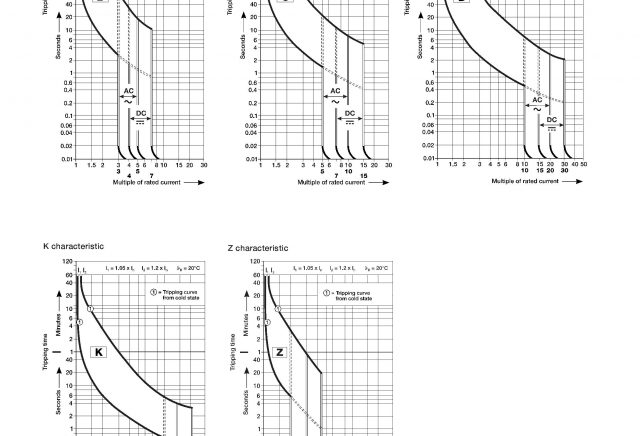Miniature circuit breakers despite being common in domestic use are not created equal. There are several types of MCBs with different tripping characteristics, each of which are designed for particular application. Table below list the different types of MCBs, their instantaneous tripping ranges, functions and governing standards.
| Type | Trip Range | Function / Use | Standard |
|---|---|---|---|
| B | (3-5)In | Protection of electrical circuits with equipment that does not cause surge current (lighting and distribution circuits) | IEC 60898-1 |
| C | (5-10)In | Protection of electrical circuits with equipment that causes surge current (inductive loads and motor circuits). | IEC 60898-1 |
| D | (10-20)In | protection of electrical circuits which causes high inrush current, typically 12-15 times the thermal rated current(transformers, welding machines etc.). | IEC 60898-1 |
| K | (8-12)In | Alternatice to D-curve MCB where narrower range is required. For applications where high levels of inrush current are expected. Its high magnetic trip point is ideal for motors and transformers. | IEC 60947-2 (Note 1) |
| Z | (2 - 3)In | Applicable where semiconductors and other components that fail open are used. The short thermal delay and low magnetic trip point are ideal for applications where devices and componentshave low surge and short circuit tolerances. | IEC 60947-2 (Note 1) |

Notes:
- Manufacturers indicate these standards, however, these standards are not explicit about these MCB types.
- B C and D types have similar thermal trips. The Magnetic trip is the difference. B C and D MCBs have an increasing degree of initial "tolerance" to overload.
- A 'B' cuve MCB installed in place of 'D' curve MCB, chances are the 'B' curve MCB contacts can weld together, or there will be nuisance trippings. However, if a 'D' curve MCB is installed where a 'B' curve MCB has to be used, the load will be damaged before the breaker trips.
- IEC 60898-1 are for domestic use (household). IEC 60947-2 are primarily for commercial and industrial use.
- Trip curves are from ABB MCB datasheet [3]
See also Implementing Type 2 Coordination to Improve the Performance of the Motor Control Center
Powered by Inline Related Posts
References:
- IEC 60898-1 2003 Electrical accessories – Circuit-breakers for overcurrent protection for household and similar installations – Part 1: Circuit-breakers for a.c. operation
- IEC 60947-2 2013 Low-voltage switchgear and controlgear – Part 2: Circuit-breakers
- ABB Miniature Circuit Breaker S 200/S 200 M Datasheet
